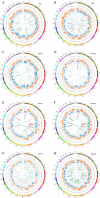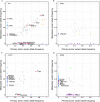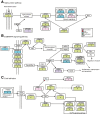Whole-genome sequencing of matched primary and metastatic hepatocellular carcinomas
- PMID: 24405831
- PMCID: PMC3896667
- DOI: 10.1186/1755-8794-7-2
Whole-genome sequencing of matched primary and metastatic hepatocellular carcinomas
Abstract
Background: To gain biological insights into lung metastases from hepatocellular carcinoma (HCC), we compared the whole-genome sequencing profiles of primary HCC and paired lung metastases.
Methods: We used whole-genome sequencing at 33X-43X coverage to profile somatic mutations in primary HCC (HBV+) and metachronous lung metastases (> 2 years interval).
Results: In total, 5,027-13,961 and 5,275-12,624 somatic single-nucleotide variants (SNVs) were detected in primary HCC and lung metastases, respectively. Generally, 38.88-78.49% of SNVs detected in metastases were present in primary tumors. We identified 65-221 structural variations (SVs) in primary tumors and 60-232 SVs in metastases. Comparison of these SVs shows very similar and largely overlapped mutated segments between primary and metastatic tumors. Copy number alterations between primary and metastatic pairs were also found to be closely related. Together, these preservations in genomic profiles from liver primary tumors to metachronous lung metastases indicate that the genomic features during tumorigenesis may be retained during metastasis.
Conclusions: We found very similar genomic alterations between primary and metastatic tumors, with a few mutations found specifically in lung metastases, which may explain the clinical observation that both primary and metastatic tumors are usually sensitive or resistant to the same systemic treatments.
Figures






Similar articles
-
Genomic sequencing identifies a few mutations driving the independent origin of primary liver tumors in a chronic hepatitis murine model.PLoS One. 2017 Nov 8;12(11):e0187551. doi: 10.1371/journal.pone.0187551. eCollection 2017. PLoS One. 2017. PMID: 29117265 Free PMC article.
-
Whole genome sequencing discriminates hepatocellular carcinoma with intrahepatic metastasis from multi-centric tumors.J Hepatol. 2017 Feb;66(2):363-373. doi: 10.1016/j.jhep.2016.09.021. Epub 2016 Oct 11. J Hepatol. 2017. PMID: 27742377
-
Inferring the progression of multifocal liver cancer from spatial and temporal genomic heterogeneity.Oncotarget. 2016 Jan 19;7(3):2867-77. doi: 10.18632/oncotarget.6558. Oncotarget. 2016. PMID: 26672766 Free PMC article.
-
Target genes discovery through copy number alteration analysis in human hepatocellular carcinoma.World J Gastroenterol. 2013 Dec 21;19(47):8873-9. doi: 10.3748/wjg.v19.i47.8873. World J Gastroenterol. 2013. PMID: 24379610 Free PMC article. Review.
-
Next generation sequencing reveals genetic landscape of hepatocellular carcinomas.Cancer Lett. 2013 Nov 1;340(2):247-53. doi: 10.1016/j.canlet.2012.09.027. Epub 2012 Oct 12. Cancer Lett. 2013. PMID: 23063663 Review.
Cited by
-
Therapeutic Application and Structural Features of Adeno-Associated Virus Vector.Curr Issues Mol Biol. 2024 Aug 2;46(8):8464-8498. doi: 10.3390/cimb46080499. Curr Issues Mol Biol. 2024. PMID: 39194716 Free PMC article. Review.
-
Recurrent glioblastoma metastatic to the lumbar vertebra: A case report and literature review: Surgical oncology.Front Oncol. 2023 Feb 16;13:1101552. doi: 10.3389/fonc.2023.1101552. eCollection 2023. Front Oncol. 2023. PMID: 36874120 Free PMC article.
-
Mutational signatures and processes in hepatobiliary cancers.Nat Rev Gastroenterol Hepatol. 2022 Jun;19(6):367-382. doi: 10.1038/s41575-022-00587-w. Epub 2022 Mar 10. Nat Rev Gastroenterol Hepatol. 2022. PMID: 35273358 Review.
-
Identification of outcome-related driver mutations in cancer using conditional co-occurrence distributions.Sci Rep. 2017 Feb 27;7:43350. doi: 10.1038/srep43350. Sci Rep. 2017. PMID: 28240231 Free PMC article.
-
Genomic Variants Revealed by Invariably Missing Genotypes in Nelore Cattle.PLoS One. 2015 Aug 25;10(8):e0136035. doi: 10.1371/journal.pone.0136035. eCollection 2015. PLoS One. 2015. PMID: 26305794 Free PMC article.
References
Publication types
MeSH terms
Substances
LinkOut - more resources
Full Text Sources
Other Literature Sources
Medical

